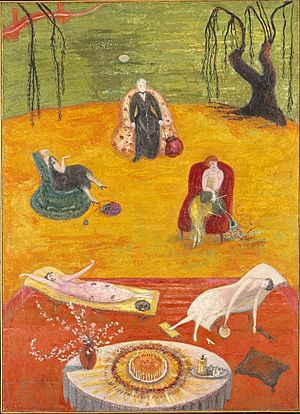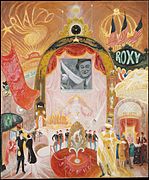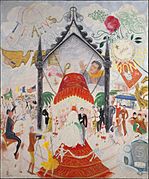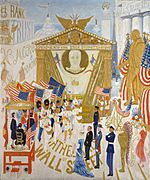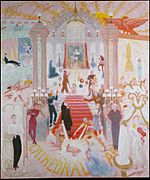Florine Stettheimer facts for kids
Quick facts for kids
Florine Stettheimer
|
|
|---|---|
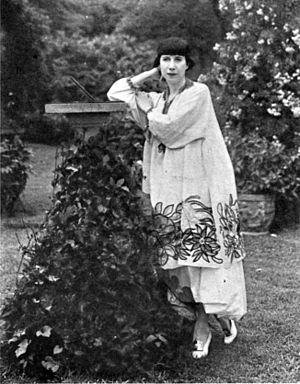
Florine Stettheimer in her Bryant Park garden c. 1917–1920
|
|
| Born | August 19, 1871 |
| Died | May 11, 1944 (aged 72) |
| Nationality | American |
| Education | Art Students League of New York |
| Known for | Painting |
Florine Stettheimer (born August 19, 1871 – died May 11, 1944) was an American modernist painter. She was also a feminist, a designer for plays, a poet, and someone who hosted special gatherings called salons.
Stettheimer created a unique, theatrical painting style. She often painted her friends, family, and scenes from her life in New York City. She and her sisters hosted a popular salon where many creative people gathered. In the 1930s, Stettheimer designed the sets and costumes for an opera called Four Saints in Three Acts. This opera was written by Gertrude Stein and Virgil Thomson. Florine is most famous for four large paintings. These paintings show what she called New York City's "Cathedrals": Broadway, Wall Street, Fifth Avenue, and the city's three main art museums.
During her life, Stettheimer showed her paintings in over 40 museum exhibitions and salons in New York and Paris. In 1938, the Museum of Modern Art sent the first American art show to Europe. Florine Stettheimer and Georgia O'Keeffe were the only women artists included. After Florine died in 1944, her friend Marcel Duchamp organized a special show of her work at the Museum of Modern Art in 1946. This was the museum's first big show for a woman artist. After her death, Florine's paintings were given to museums all over the United States. Besides her many paintings and designs, she also made custom frames for her art and matching furniture. She also wrote funny and sometimes critical poems. A book of her poems, Crystal Flowers, was published after she died by her sister Ettie in 1949.
Florine Stettheimer: An Artist's Journey
Early Life and Learning
Florine Stettheimer was born in Rochester, New York, on August 19, 1871. Her mother, Rosetta Walter, came from a wealthy German-Jewish family in New York. Florine's father, Joseph, left the family for Australia. Florine grew up mostly with her mother and sisters, spending time between New York City and Europe.
From age 10 to 15, Florine went to a girls' boarding school in Stuttgart, Germany. She took private art lessons there. The family lived in Berlin from 1887 to 1889, where Florine continued her drawing lessons. She traveled often through Europe with her mother and sisters, Carrie and Ettie. Florine taught herself art history by visiting museums and galleries in Italy, France, Spain, and Germany. She studied the works of famous old artists and wrote her thoughts about them in her diaries.
In 1892, Stettheimer joined the Art Students League of New York. This school was like the private art schools in Paris. She learned to paint realistic portraits in different European styles. After finishing school, she went back to Europe. She saw modern art by artists like Cézanne, Manet, and Matisse. She tried different art styles, from Symbolism to Pointillism.
Designing for the Stage
In 1912, Florine was very inspired by the Ballets Russes performances in Paris. She loved their stage designs and dances. This led her to create her own opera called Orphée des Quat'z Arts. She wrote the story, designed the costumes, and planned the sets. She made small models with tiny, detailed costumes. These models showed lively, dance-like movements. This creative work helped shape her unique painting style that appeared later.
She used a new clear material called cellophane in her designs. Cellophane became a special part of her interior designs. Two decades later, she used it for the stage sets of the opera Four Saints in Three Acts. Her opera Orphée des Quat'z Arts was never performed on a real stage.
A Special Gathering Place: The Stettheimer Salon
In 1914, the Stettheimer family was stuck in Bern, Switzerland, because World War I started. They eventually sailed back to New York. When Florine returned, she decided to change her art style. She wanted to paint the exciting sights, sounds, and people of 20th-century New York City.
The four Stettheimer women moved into an apartment in Manhattan. There, they started hosting special gatherings called salons. They invited many artists, writers, and musicians. Famous guests included Marcel Duchamp, Georgia O'Keeffe, and Marsden Hartley. Florine's older sister Carrie made unique drinks and dishes for these parties. In the summers, they often had day-long parties at rented houses. Florine painted many of these outdoor gatherings of her family and friends.
Florine's Unique Painting Style
Florine Stettheimer had only one solo art show during her lifetime, in 1916. The show featured her early works with bright colors and thick paint. When none of her paintings sold, she felt a bit disappointed. In the next year, Florine's style changed. She developed her own special way of painting. She went back to the small, theatrical, and colorful ideas from her Orphée des Quat'z Arts designs.
In Florine's later works, each painting looks like a stage. It is filled with family members, friends, and people she knew. She used bright, pure colors, often against a flat white background. Many of her paintings have small, detailed, and funny touches. For example, in Cathedrals of Fifth Avenue (1931), a small altar boy tries to peek under the bride's dress. Florine also filled her paintings with recognizable people in real New York locations.
Paintings of the 1920s
The 1920s were a very busy time for Stettheimer. She painted many portraits of her male friends, herself, and her family. Instead of just showing what someone looked like, Florine's portraits showed their personality. She included their habits, jobs, and achievements. For example, in her Portrait of Marcel Duchamp and Rrose Sélavy, she included some of his famous "readymades" (everyday objects he turned into art). She also showed his female alter ego, Rrose Sélavy.
Stettheimer also painted large works about important topics. One example is Asbury Park South (1920). This painting shows African-Americans enjoying a beach in New Jersey that was separated by race at the time. This painting is special because it was one of the first by a white American artist to show Black figures without making them look like cartoons. In Lake Placid (1919), she painted herself and friends of different religions enjoying a day at Lake Placid. This place was known for not being welcoming to Jewish people at the time.
Paintings of the 1930s
During the 1930s, Stettheimer continued to paint large works. Some of these paintings focused more on her family and familiar places. Every year on her birthday, she painted a floral still-life. She called it an "eyegay," a playful twist on the word "nosegay" (a small bouquet). She spent a lot of time designing for the opera Four Saints in Three Acts. She also worked on two of her "Cathedral" paintings during this time.
The "Cathedral" Paintings
Starting in 1929, Florine Stettheimer painted four large works she called "Cathedral" paintings. These paintings celebrated what she saw as the important "secular shrines" of New York City. These included the new theater and movie areas of Times Square and Broadway. She also painted Wall Street as the center of money and politics. Another painting showed Fifth Avenue's fancy stores and high society. The last one showed the competition among New York's three main art museums: the Museum of Modern Art, the Metropolitan Museum of Art, and the Whitney Museum of American Art. She worked on The Cathedrals of Art until just weeks before she died, and it remains unfinished. All four paintings are now displayed at the Metropolitan Museum of Art.
Four Saints in Three Acts Opera
In 1934, Four Saints in Three Acts opened in Hartford, Connecticut. This was the first avant-garde (very new and experimental) opera in America. It was very popular and sold out. Gertrude Stein wrote the story, and Virgil Thomson wrote the music. All the performers were African Americans, and many became successful musicians.
Stettheimer designed the stage and the costumes for the opera. Thomson asked her to design it after seeing her paintings, her custom frames, and her studio's cellophane curtains. For the show, Florine made dolls with full costumes for each character. She also created designs for each scene in small shoe boxes. She covered the entire back of the stage with layers of cellophane. She made palm trees from cellophane and feathers. She even copied her own furniture for the stage sets. The opera got mixed reviews, but everyone praised Stettheimer's amazing costumes and sets.
Her Humorous Poems
Stettheimer wrote her poems on small pieces of paper. Her sister Ettie collected them and had them privately published. Some of her poems are like nursery rhymes. Others offer funny social comments. Some are humorous descriptions of her fellow modern artists, like Gertrude Stein and Marcel Duchamp. Her poems show she was aware of popular culture. They also sometimes made funny comments about marriage. Her poems were put together in a book called Crystal Flowers. Her sister Ettie edited it and published a limited edition in 1949.
Her Lasting Impact
Florine Stettheimer died of cancer on May 11, 1944, in New York Hospital. She had always wanted all her artwork to be given to a museum as one collection. However, she later changed her will. She asked her sisters to make sure her works were not sold. Instead, they should be donated to museums across the country. Her sister Ettie and friends helped donate Florine's paintings to many major art museums in the United States. This included giving the "Cathedral" paintings to the Metropolitan Museum of Art.
When Marcel Duchamp heard of her death, he asked if he could organize a special show of her paintings. This exhibition at the Museum of Modern Art was the first big show for a woman artist there. It later traveled to other museums.
Throughout her life, art galleries often asked Stettheimer to join them. She did show her work in many places. But when asked to sell her paintings, she priced them very high. This meant no one could afford them. As her friend, art critic Henry McBride, noted, she liked her pictures and preferred to keep them. Still, she often lent her art to public exhibitions.
By the 1930s, she was one of the best-known women artists in New York, second only to Georgia O'Keeffe. After her death, writer Carl Van Vechten said that Stettheimer "was both the historian and the critic of her period." He said she showed how people in New York lived after World War I, using "brilliant colors and assured designs."
After her death in the late 1940s, when her works were given to museums, art tastes changed. People were more interested in abstract expressionism. So, her paintings were often not displayed. Also, because her paintings were not sold in galleries or auctions, her name and work were not as well known. In the 1970s, her work became popular again thanks to feminist art historians. In 1995, there was another big show of her work. Since 2015, her work has been in many exhibitions. Her importance as an early feminist artist and her influence on modern artists are now much more recognized.
Where to See Her Art
- Asbury Park South - halley k harrisburg and Michael Rosenfeld, New York
- La Fete A Duchamp - private collection
- West Point - This painting was given by Ettie to the West Point Military Academy after Stettheimer's death. It has been missing since the 1950s.
- The largest collection of her works (65 pieces) is at the Avery Architectural and Fine Arts Library at Columbia University. This includes her early student works, Portrait of Myself, and portraits of her two sisters. Columbia also has the dolls and models for Four Saints in Three Acts and Pocahontas.
- The second-largest collection (56 works) is at the Museum of Modern Art. This includes Family Portrait #2, Portrait of My Mother, and all her drawings and models for her Orpheus ballet.
- Metropolitan Museum of Art - the Cathedral series: Cathedrals of Broadway (1929), Cathedrals of Fifth Avenue (1931), Cathedrals of Wall Street (1939), Cathedrals of Art (1942–)
- Whitney Museum of American Art - New York/Liberty (1918–19), Sun (1931)
Most art museums in large cities across the United States that were created before 1950 have at least one painting by Stettheimer. A few university art museums, like the University of California at Berkeley and the Stanford University Museum of Art, also have her works. These paintings were given out after she died, following her wishes.
See also
 In Spanish: Florine Stettheimer para niños
In Spanish: Florine Stettheimer para niños
- Stettheimer Dollhouse


